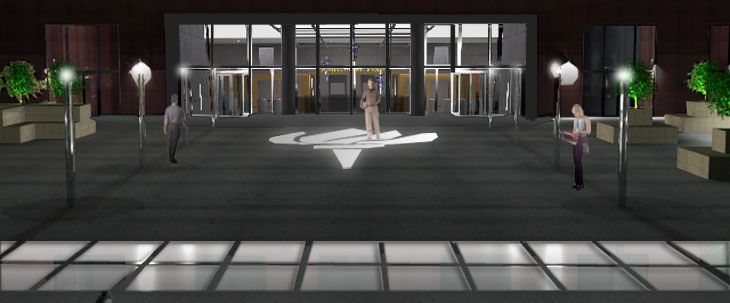New York University Concourse Project

| |
| Resume & Portfolio |
Building Statistics |
| Reflection |
![]()
Building Statistics
Project: New York University Concourse Project
Location: 44 West 4th Street, New York, NY 10012
Building Occupant: Education/University
Size: 70,000 sq.ft
Number of stories above grade: 1 story above grade, 2 below grade
Owner: New York University Stern School of Business
Architect: Perkins + Will
MEP Engineer: BR+A
Structural Engineer: Severud
Construction Dates: Fall 07 - Fall 09
Overall Building Cost: $35 million
Project Delivery: Design Bid Build
Architecture: The project consist of a multi-story atrium space that connects the plaza level with the upper and lower concourses. The upper concourse consist of a multi-purpose student lounge, classrooms, and gathering spaces. The lower concourse level includes research labs and classrooms as well.
Codes: NYC Building Code 2004 and NFPA Life Safety 101
Zoning: Commercial
Historical Requirements of Building: The building falls under the New York City Landmarks Law which is concerned with the preservation of the city's architectural, historical, and cultural heritage buildings. The construction for the NYU Concourse Project will deal with reconstructing the interior spaces.
Building Envelope: The project spans across three buildings (Tisch, KMC, Shimkin). All of the renovation and construction takes place under the existing three buildings. A newly constructed skylight on Gould Plaza will bring light to the upper concourse. Newly constructed wall systems will be incorporated into the existing system.
Construction: The 70,000 sq. ft. New York Concourse Project involvess the revonation of the NYU Stern School of Business. Designed by Perkins + Will, the project involves the lobby renovation of Shimkin, Kaufman Management Center, & Tisch Hall as well as the upper and lower concourses that span the three buildings. The design bid build project is divided into three phases, with the preliminary phase starting in the fall of 2007 which involves the demolition and build out of Shimkin basement. Phase one involves the preconstruction of the Tisch Lobby and lower concourse lobby and classrooms. Phase two involves the construction of the upper concourse lobby and classrooms and the KMC & Shimkin lobby modifications. Lastly, phase three involves the completion of the Tisch Lobby. The project is anticipated to be finished in the fall of 2009 with a total budget of $35 million.
Electrical: The electrical system for the New York University Concourse project consist of new panel boards connected to an existing cogen main service switchboard. Since the project consists of building under three existing buildings, new electrical rooms were added to provide service for the new spaces. A common panel board would service 277/480V, 400A. There is also 120/208V 3φ, 4W, 225A panels boards. The fire alarm emergency system also has its own set of panel boards. New valves are added to the existing reserve tank.
Lighting: The lighting system consists of a variety of light sources to satisfy the cool and warm surfaces of the spaces; fluorescent, high intensity discharge, halogen, and LEDs. Fluorescents such as the T5, T8, and compact fluorescents, with a correlated color temperature of 3000K, are used accent and ambient cool surfaces such as the stones and metals in the lobby and the lower concourses of the project. A mixture of fixtures such as wall washers, linear direct/indirect luminaire, suspended pendants, and adjustable downlights are employed to achieve this effect. Warm white 3000K LED linear are also integrated for wall grazing and integrated inside of acrylic panels to provide a decorative lighting. For warmer surfaces such as the wooden panels, 37W MR16 halogen sources are used to provide a cozy and comfortable feel. With spaces that require a light source with high intensity output, ED17 and ceramic metal halide PAR20s are employed.
Mechanical: The mechanical systems of the New York Concourse Project consist of a mixture of VAV and constant volume box system. The newly added Air Handling Unit in Tisch Hall can handle 6,200 cfm. Existing air handling units also supplies air throughout the upper and lower concourses. The renovation involves the removal of existing ductwork/piping and installation of newer ducks.
Structural: The structural system for the New York Concourse Project consists of only the addition and removal of beams and girders to the existing structure. Most of the addition takes place below grade. The existing structure consists of WF members and includes metal and steel framing. The column sizes are W12 with concrete slab thicknesses of 51/2” to 6”. The typical floors are 3” (18 gage metal deck + 3.25 light weight concrete). The structure bays range from 21’ x 21’ up to 63’ x 21’. A typical added new beam is W14 x 26.
Fire Protection: The Fire Alarm System Control Panel (FACP) will include manual pull stations, smoke detectors, and photoelectric smoke detectors to detect a fire. In an outbreak of fire, the FACP will send out emergency responses. Most of the walls are two hour fire rated.
Transportation: One service elevator and three passenger elevators serve Tisch Hall. The main atrium stairs in the lobby connect the ground, upper, and lower concourses. Tisch Hall also has five sets of stairs that connect the various levels of the building.
Telecommunication: Data and telecom systems are provided through the data jacks that are located throughout the renovated rooms of Tisch Hall. The data jacks help provide service for the internet and phone equipment. There are also A/V systems located through the renovated spaces. The renovated spaces are classrooms, lecture halls, lounge areas, auditorium, and lobbies of the three buildings.
Air Quality Monitoring System: The air quality monitoring system will utilize local room sensors and duct probes to sample air quality. Air quality monitoring system will continuously sample air and environmental conditions via the internet. BACNET, a data communication protocol, will be employed for building automation systems.